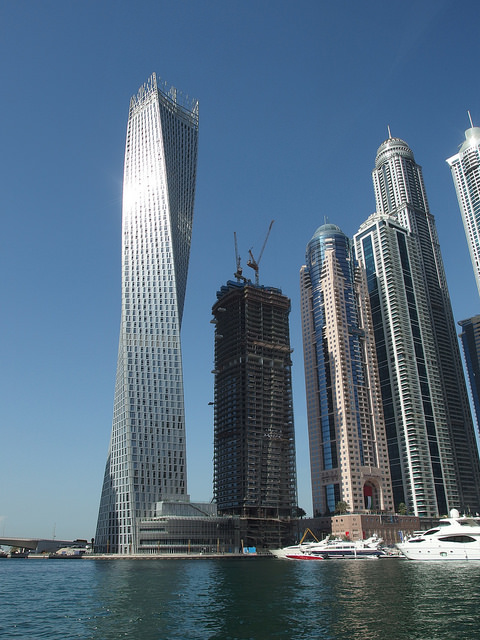Lesson 11
Prisms Practice
- Let’s calculate volumes of prisms and cylinders.
11.1: New Heights
Calculate the height of each solid. Round your answers to the nearest tenth if needed.
A

B

11.2: The Choice is Yours
Here are several solids.
A

B

C

D

E

F

G

- Without doing any calculating, identify 2 solids you think would have the least difficult volume calculations and 2 solids that would have the most difficult volume calculations. Be prepared to explain your reasoning.
- Choose 3 of the solids. At least 1 should be from your “least difficult” list and 1 should be from your “most difficult” list. Calculate the volumes of the solids you chose. Round your answers to the nearest tenth if needed.
The images show a solid and the two-dimensional figure that was rotated to generate it.


Find 4 different positive integers for the values of \(A,B,C,\) and \(D\) so that the total volume of the solid is \(297\pi\) cubic units.
11.3: The Cayan Tower
The building on the left side of the picture is called the Cayan Tower. It’s in the city of Dubai. The tower is about 306 meters tall. It’s made up of identical floors that are each rotated slightly compared to the one underneath it.

floor plan

Each floor is the same chevron shape that is approximately 2 parallelograms put together, with the dimensions shown in the image. The circle in the floor plan shows the cross section of the core, which is used to circulate air and carry pipes and wiring throughout the building.
- The area of the Cayan Tower’s base is \(57 \boldcdot 35\) or 1,995 square meters. Why is it possible to find the area of the chevron shape by just multiplying its width and height?
- Describe how the total volume of the building (including the core) can be calculated.
- What shape is the core of the building, whose cross section is shown in the floor plan as a circle?
- Describe how the volume of the building’s core can be calculated, including describing the measurements that would be used.
- What percentage of the building’s volume is taken up by its core?
Summary
The formula \(V=Bh\), where \(V\) stands for volume, \(B\) is the area of the base, and \(h\) is the height, applies to right and oblique cylinders and all prisms. Sometimes, though, additional calculations are needed to find missing measurements before the formula can be applied.
To calculate the volume of this cylinder, first find the area of the base, which is a circle of radius 5 cm. Its area is \(25\pi\) square centimeters. The cylinder’s height isn’t given. To find the value of the height, notice that a right triangle is formed by the 15-cm diagonal line, the 10-cm diameter of the circle, and the height of the cylinder. The diagonal line is the triangle’s hypotenuse. By the Pythagorean Theorem, \(10^2+h^2=15^2\). That means \(100+h^2=225\). Subtracting 100 from each side gives \(h^2=125\), so \(h=\sqrt{125}\) centimeters.

Now, the volume of the cylinder is the area of the base multiplied by the height. This is \(25\pi\boldcdot\sqrt{125}\) cubic centimeters, or approximately 878.1 cubic centimeters.
Glossary Entries
- Cavalieri’s Principle
If two solids are cut into cross sections by parallel planes, and the corresponding cross sections on each plane always have equal areas, then the two solids have the same volume.
- oblique (solid)
Prisms and cylinders are said to be oblique if when one base is translated to coincide with the other, the directed line segment that defines the translation is not perpendicular to the bases.
A cone is said to be oblique if a line drawn from its apex at a right angle to the plane of its base does not intersect the center of the base. The same definition applies to pyramids whose bases are figures with a center point, such as a square or a regular pentagon.
- right (solid)
Prisms or cylinders are said to be right if when one base is translated to coincide with the other, the directed line segment that defines the translation is perpendicular to the bases.
A cone is said to be right if a line drawn from its apex at a right angle to the plane of its base passes through the center of the base. The same definition applies to pyramids whose bases are figures with a center point, such as a square or a regular pentagon.





